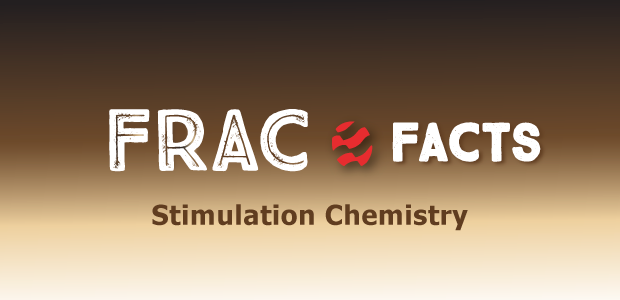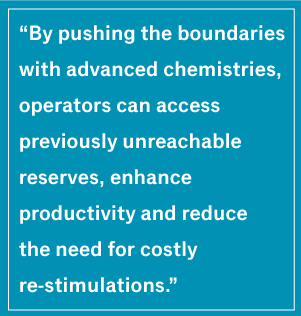
Well Stimulation Chemistry Innovation Continues
By Jeremy Viscomi
Well-stimulation technology has been a key driver of production growth and efficiency in the oil and gas industry. Independent operators, who often work in economically and geologically challenging environments, continually seek to boost well productivity and extend the lives of mature fields. In the quest to maximize well performance, the chemistry behind well stimulation has seen remarkable advancements, transforming from basic acidizing and hydraulic fracturing practices to sophisticated, engineered solutions that push the limits of production.
Today, the chemistry used in well stimulation has evolved to provide operators with highly specialized formulations tailored to specific reservoir conditions. These chemistries are engineered to maximize productivity, increase fracture complexity and extend the reach of stimulation treatments in previously unattainable ways.
Hydrochloric acid remains a popular acidizing choice; however, it is often enhanced with additives such as corrosion inhibitors, iron control agents and surfactants. High-temperature organic acids, such as formic and acetic acid, also are used to extend reaction times and penetrate deeper into the formation. These advanced acid systems improve effectiveness in deep, high-temperature formations, improving productivity and reducing the need for re-stimulation.
Hydraulic fracturing fluids also have advanced significantly. Modern formulations include slickwater, hybrid and crosslinked gel systems that maximize proppant transport and fracture conductivity. Slickwater formulations use friction reducers to allow higher pump rates, creating longer and more complex fractures. Crosslinked gels, on the other hand, increase viscosity, which improves proppant placement in reservoirs with high closure pressures.
Engineered or “smart” fluids represent another leap in stimulation technology. Designed to respond to specific well conditions, these fluids include self-diverting acids that selectively treat areas within the formation according to flow restrictions. By diverting treatments to under-stimulated zones, operators can maximize the uniformity and effectiveness of the acidizing process.
Data-driven real-time monitoring has further enhanced stimulation performance. By monitoring downhole conditions, operators can adjust treatment parameters on the fly, optimizing fluid formulations and maximizing fracture geometry. This approach, known as precision stimulation, leverages real-time data to ensure that each well receives an optimized treatment tailored to its unique characteristics.
In the coming years, proppants and fluid systems are expected to evolve to address the increasing demands of ultra-deep, high-stress reservoirs. High-strength ceramic proppants and specially engineered fluids that maintain stability under extreme pressures and temperatures will sustain productivity in challenging conditions. Increasing fracture conductivity in harsh environments without compromising proppant placement or fracture integrity will be a game-changer.
Nanotechnology opens new possibilities for delivering reactive agents more precisely. Nanoparticles, designed to carry acid or other reactive agents, can be directed to specific areas within the formation, enabling highly targeted treatments. These advanced chemistries will allow operators to focus stimulation on high-potential zones, increasing treatment effectiveness while minimizing chemical waste. Nanotechnology also holds the potential for real-time downhole diagnostics, enabling even greater treatment precision and ensuring optimal fracture development.
Next-generation crosslinked and hybrid gels also are under development to improve proppant transport capabilities and fracture stability. These gels will be engineered to withstand high closure stresses and deliver proppant further into the fracture network, maximizing fracture conductivity over time. For independent operators, this means sustained production gains and improved recovery from each well, despite challenging geological environments.
Fully autonomous stimulation systems may represent the future of well stimulation, allowing for dynamic adjustments in chemical dosing, fluid composition, and proppant concentration in real time. These systems would use artificial intelligence and machine learning algorithms to continuously analyze downhole data, automatically optimizing treatment parameters for peak performance. Autonomous stimulation has the potential to eliminate inefficiencies, ensuring that each treatment is optimized for maximum recovery.
Advanced diagnostic tools, combined with predictive fracture modeling, are set to play a more significant role. These tools will enable operators to visualize fracture networks, assess proppant placement and monitor flow dynamics. Enhanced diagnostic capabilities will ensure that every aspect of a stimulation is accounted for, enabling even greater control and performance.
By pushing the boundaries with advanced chemistries, operators can access previously unreachable reserves, enhance productivity and reduce the need for costly re-stimulations.

JEREMY VISCOMI is a strategic marketing expert for the oil and gas industry. Among his many roles, he serves as the Mid-Continent regional lead for the Petroleum Technology Transfer Council, providing independent operators with access to emerging technology aimed at reducing risk and growing profits.
For other great articles about exploration, drilling, completions and production, subscribe to The American Oil & Gas Reporter and bookmark www.aogr.com.







